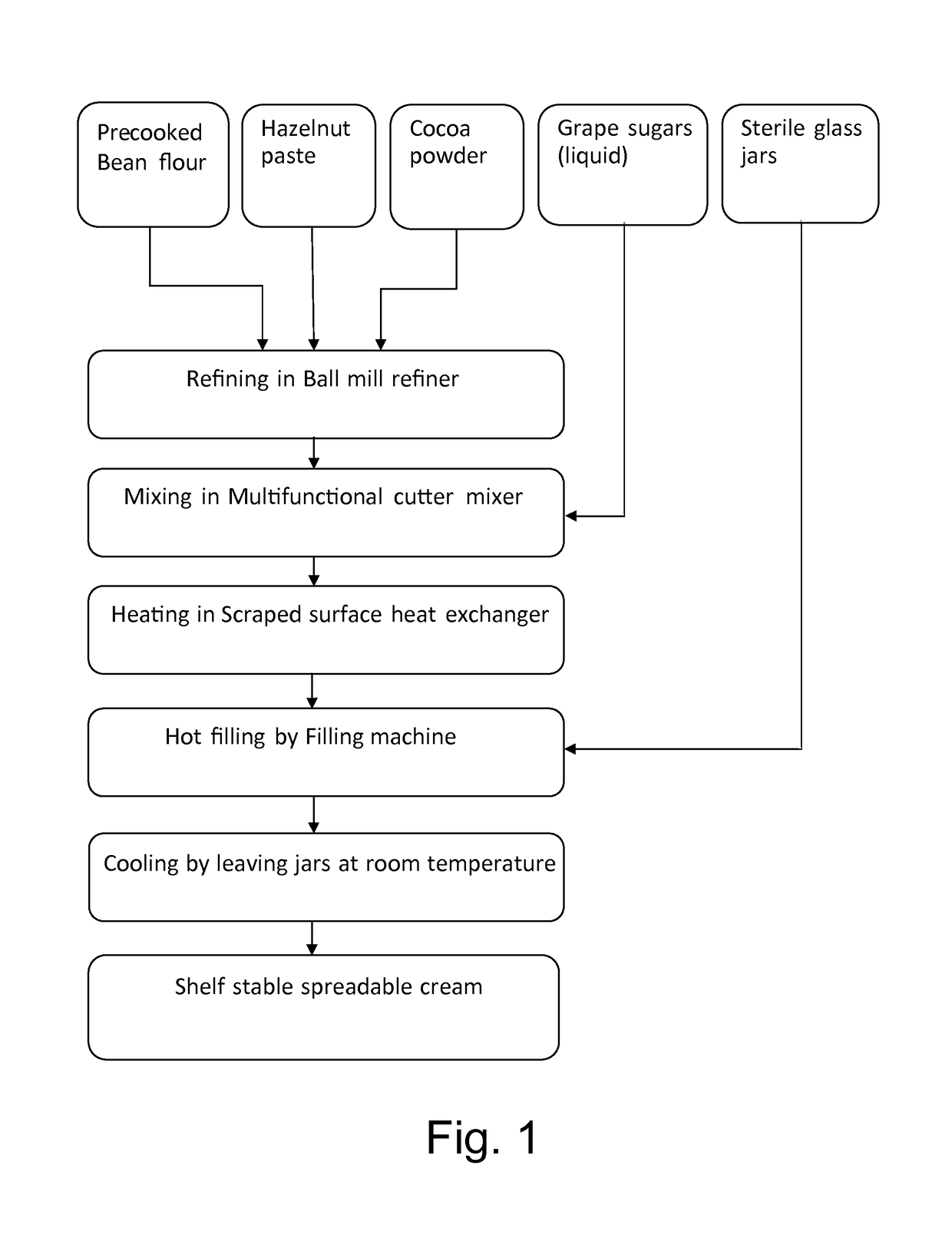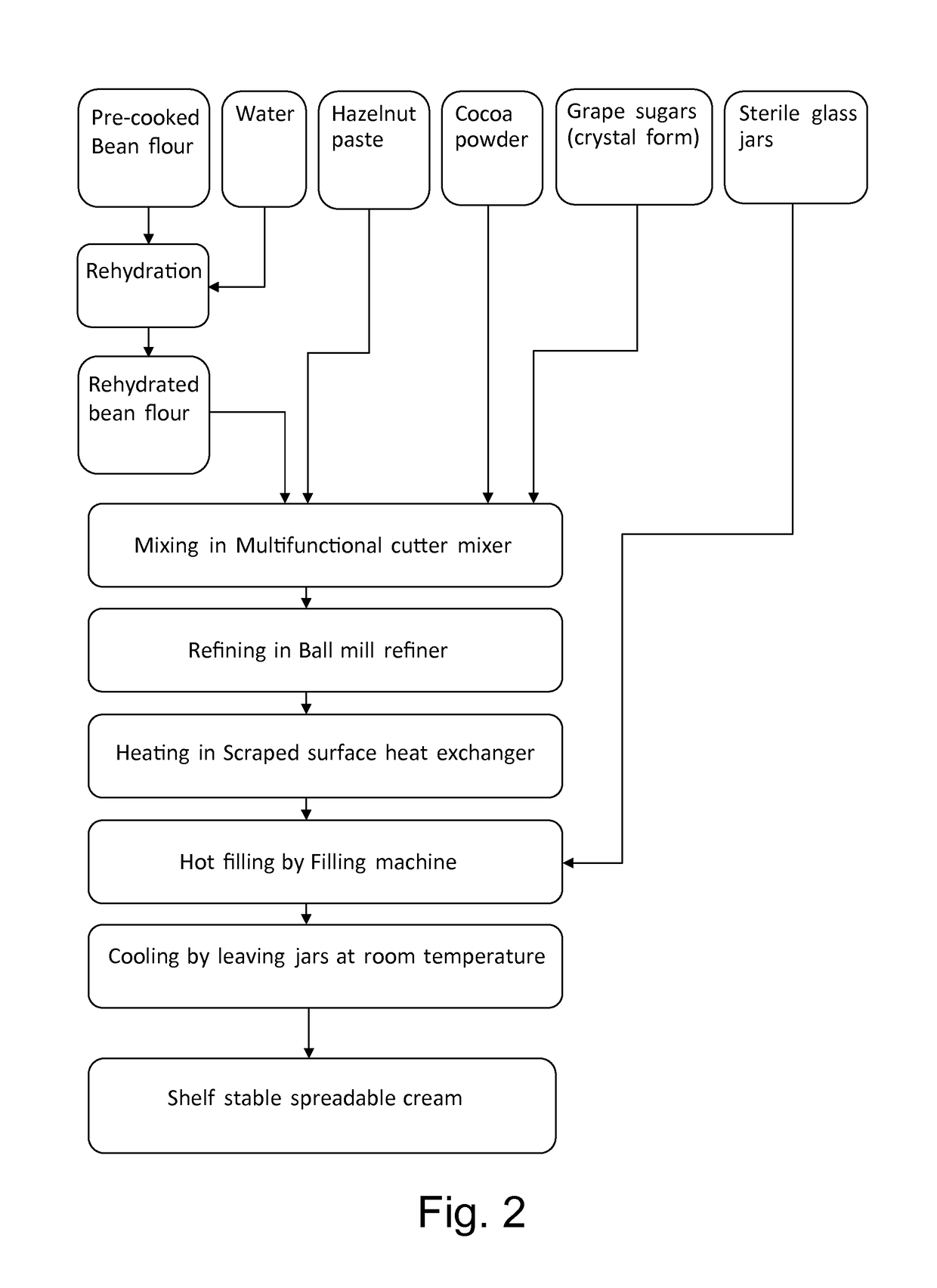Shelf-stable spreadable cream
a spreadable cream, shelf-stable technology, applied in the field of shelf-stable spreadable cream, can solve the problems of high caloric content, high calories, and high fat content of prior art spreadable creams, and achieve the effects of high relative sweetness value, softening spreadability, and good tas
- Summary
- Abstract
- Description
- Claims
- Application Information
AI Technical Summary
Benefits of technology
Problems solved by technology
Method used
Image
Examples
example 1
[0177]Production of a Cocoa-Hazelnut Shelf-Stable Spreadable Cream (see FIG. 1)
[0178]The following dry ingredients (Table 1) were weighed and dosed in a ball mill refiner (model Roboqbo Qb8-3, produced by Roboqbo, Bologna, Italy) having a rotor shaft with arms for stirring, having a capacity of 8 l, tank dimensions of 85×65×88 cm, and provided with inox stainless steel beads and mixed at a peripheral speed of 80 rpm at room temperature until a smooth semi-processed composition was formed (about 6 hours).
[0179]
TABLE 1List of dry ingredientsIngredientWeight (g)Pre-cooked cannellini bean flour2560Hazelnut paste4220Cocoa powder420
[0180]After this operation, the semi-processed paste was mixed, at room temperature, with 12800 g of grape sugars in liquid form (35% (w / v) concentration) in a multifunctional mixer cutter (Roboqbo NS25, produced by Roboqbo, Bologna, Italy) having a capacity of 25 l and provided with a rotor blade until a smooth and emulsified spreadable cream composition was f...
example 2
[0182]Production of a Cocoa-Hazelnut Shelf-Stable Spreadable Cream (see FIG. 2)
[0183]The following ingredients (Table 2) were weighed and dosed, at room temperature, in a batch tank multifunctional cutter mixer (Roboqbo NS25, produced by Roboqbo, Bologna, Italy) having a capacity of 25 l and provided with a rotor blade and mixed to obtain a semi-processed composition.
[0184]
TABLE 2List of ingredientsIngredientWeight (g)Pre-cooked rehydrated cannellini bean flour7040Hazelnut paste4220Cocoa powder420Grape sugars in crystal form8320
[0185]The content was then transferred to a ball mill refiner (Roboqbo Qb25-3, produced by Roboqbo, Bologna, Italy) having a rotor shaft with arms for stirring, having a capacity of 25 l, tank dimensions of 110×98×155 cm, and provided with inox stainless steel beads and mixed at a peripheral speed of 80 rpm at room temperature until a smooth and emulsified spreadable cream composition was formed (about 6 hours).
[0186]The emulsified cream thus formed was then ...
example 3
[0187]Characteristics of the Cocoa-Hazelnut Shelf-Stable Spreadable Cream
[0188]The following parameters of the shelf-stable spreadable cream of Example 1 were measured after production: water activity (aw), moisture content, viscosity, pH, presence of phase separation. The following Table 3 lists the method of measurement and the measurement value for each parameter. Each measurement value is an average of three measurements.
[0189]
TABLE 3Measurement values of parameters of the shelf-stablespreadable cream of Example 1MeasurementParameterMethod of measurementvalueWaterDew point method. Aqualab water0.77Activity (aw)activity meter T4e (Decagon Devices,USA)MoistureDrying with an air-ventilated oven25.3content(measurement of the weight loss)(MC %)ViscosityBrookfield viscometer @ 12 RPM38000 cPand 20° C.pHpH meter5.5Presence ofVisualNophaseseparation
[0190]The nutritional information of the shelf-stable spreadable cream of Example 1 was calculated, based on the ingredient composition of t...
PUM
 Login to View More
Login to View More Abstract
Description
Claims
Application Information
 Login to View More
Login to View More - R&D
- Intellectual Property
- Life Sciences
- Materials
- Tech Scout
- Unparalleled Data Quality
- Higher Quality Content
- 60% Fewer Hallucinations
Browse by: Latest US Patents, China's latest patents, Technical Efficacy Thesaurus, Application Domain, Technology Topic, Popular Technical Reports.
© 2025 PatSnap. All rights reserved.Legal|Privacy policy|Modern Slavery Act Transparency Statement|Sitemap|About US| Contact US: help@patsnap.com



